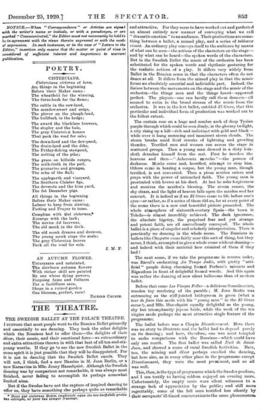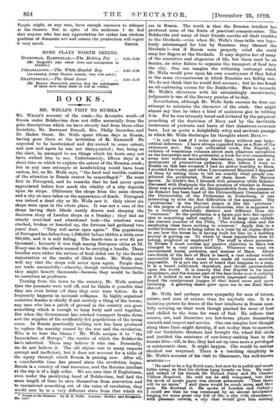THE THEATRE.
THE SWEDISH BALLET AT THE PALACE THEATRE. I surrosu that most people went to the Russian Ballet primarily and essentially to see dancing. They took the other delights which the Russians had to offer them—the delights of their decor, their music, and their emotional force—as extraordinary and extra attractions thrown in with that best of all ten-and-six- penny worths. If they go to see the new Swedish Ballet in the same spirit it is just possible that they will be disappointed. For it is not in dancing that the Swedish Ballet excels. They will not, I think, find a new Maseine in M. Jean Borlin, or a new Karsavina in Mlle. Jenny Hasselquist. Although the Swedish dancing was by comparison not remarkable, it was always most finished, never /Wing to accomplish its perhaps somewhat limited aims.
But if the Swedes have not the rapture of inspired dancing to offer us, they have something else perhaps quite as remarkable • Deus nut detentes Helim implosion aqua its nos ineff abili gratis tea adimple. iit pace tow sniper fruemur. and attractive. For they seem to have worked cut and perfected an almost entirely new manner of conveying what we call " dramatic emotion " to an audience. Their productions are some- thing between a ballet, a mimed play, and a series of tableaux vitunt. An ordinary play conveys itself to the audience by means
of what can be seen—the actions of the characters on the stage—
and by what can be heard—the spoken words of tho characters. But in the Swedish Ballet the music of the orchestra has been substituted for the spoken words and rhythmic gesturing for the realistic actions of a play. It differs very widely from Ballet in the Russian sense in that the characters often do not dance at all. It differs from the mimed play in that the music forms an absolutely essential and indivisible part. Indeed, the liaison between the movements on the stage and the music of tho orchestra—the things seen and the things heard—appeared perfect. The players—one can hardly call them dancers—all seemed to swim in the broad stream of the music from the orchestra. It was in the last ballet, entitled El Greco, that this particular and individual form of production sea worked out to the fullest extent.
The curtain rose on a huge and sombre arch of deep Tyrian purple through which could be seen dimly, in the gloomy twilight,
a city rising up a hill—rich and indistinct with gold and black—
while over it hung menacing and imminent storm clouds. The storm breaks amid livid streaks of lightning and growling thunder. Terrified men and women run across the stage in scattered groups. Then a young man dressed in a dirty loin- cloth detaches himself from the rest. First he invokes tho heavens and then—" Acheronta movebo "—the powers of darkness. Monks enter and, horrified, attempt to stop bins.
Others come in bearing a corpse, but the young man, though terrified, is not converted. Then a pious maiden enters and prays with the power of untouched faith. The young man is prostrated with horror at his deed. At last he asks forgiveness and receives the maiden's blessing. The storm ceases, the sky clears, and the light of heaven falls upon the maiden and her convert. It is indeed as if an El Greco came to life before one's eyes—or rather, as if a series of them did so, for at every point of the scene there is a new and beautiful picture presented. The whole atmosphere of sixteenth-century Spain—the town is Toledo—is almost incredibly achieved. The dark ignorance, the absolute bigotry, the perpetual fear and yet strange and potent faith, are all marvellously conveyed. The whole ballet is a piece of singular and scholarly interpretation. There is practically no dancing in the whole scene. The Russians in ballets like Cleopatre come fairly near this sort of thing, but they never, I think, attempted to give a whole scene without dancing— and indeed with their material how criminal of them if they had !
The next scene, if we take the programme in reverse order, was Ravel's enchanting Au Temps Jadie, with pretty " arti- ficial " people doing charming formal Forlane's minuets and Rigaudons in front of delightful formal woods. And this again was rather the dancing of now silent ballrooms than of modern ballet.
Before that came Les Vierges Fates—a delicious Scandinavian, wooden toy rendering of the parable ; M. Jean Borlin was entrancing as the stiff-jointed bridegroom in green (what a tour de force this made with his " young man " in the El Grew scene!), and Mlle. Hasselquist equally delightful as the young, shy but triumphantly joyous bride, while the work of the ten virgins made perhaps the most attractive single feature of the programme.
The ballet before was a Chopin Divertissem^nt. Here there was no story to illustrate and the ballet had to depend purely on its dancing ; and here, therefore, ono was most tempted to make comparisons with the Russians—which could have only one result. The first ballet was called Nuit de Saint- Jean, and showed a scene of rural Swedish festivities. Here, too, the miming and decor perhaps excelled the dancing, but here also, as in every other place in the programme except Divertissement, they were the most prominent, and so all was well.
This, then, is the type of programme which the Swedes produce, and I can testify to having seldom enjoyed an evening more.
Unfortunately, the empty seats were silent witnesses to a strange lack of appreciation by the public ; and still more regrettably, some of the full ones testified less silently by their occupants' ill-timed conversationto the same phenomenon. People might, at any rate, have enough manners to whisper IA the theatre. But in spite of the audience I do feel that anyone who has any appreciation for rather lees obvious qualities of dramatio art and misses the production will regret



































 Previous page
Previous page